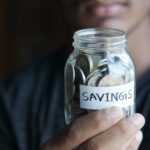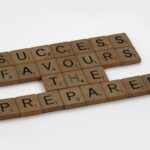During the new year everyone worries about their weight, counts their steps, and tracks calories. What about finances, though? They are just as much a part of your fitness journey as what you eat and how much you move. The more financially fit you are, the less stress you experience, and guess what? Stress and your physical health go hand-in-hand! Budgeting, goal setting, saving and investing are all part of financial fitness. Are you ready to be financially fit? Read more to test your fitness level, if you haven’t met your financial goals don’t worry, this is the perfect time to start.
Budgeting is Key
I know, you hear the word budget, and you want to run away. Budgeting feels like restriction, right? It tells you what you CAN’T do just as much as a strict diet tells you what you can’t eat.
What if you looked at it differently?
Instead, look at budgeting as empowering. I like to think of it like a roadmap for my money. If you’re anything like me, you wouldn’t jump in the car to drive three states over without consulting your GPS, right?
The same is true of your money. It needs to be told where to go. Without a budget, you’ll spend haphazardly and inadvertently miss the chance to save and invest in your future.
A budget helps you organize your money. You’ll know exactly where each dollar needs to go. Your budget should include not only your regular bills but savings and investments too. Make saving and investing a regular part of your budget, treating it just like a bill – it’s non-negotiable.
Saving is a Must for Everyone
Saving could mean a few things, but it’s a key component of your financial fitness journey. For example, EVERYONE must have an emergency fund.
You only use an emergency fund if you’ve lost your job, fallen ill, or can’t work for some other reason. It should have 3 – 6 months of expenses in it to help you through the difficult time without having to worry about your finances.
Once you have an emergency fund, consider the following accounts to maximize your financial fitness.
Sinking Fund
If you are saving for something big, like a vacation or to buy a car, set up a sinking fund. In the fund, you save as much as you can each month, but keep the account earmarked for your intended goal.
Rainy Day Fund
We all have those expenses that sneak up on us when we least expect it. A flat tire, house repair, or unexpected medical bill can throw off even the most perfect budget. A rainy day fund is funds you have set aside for these occasions. You can dip into the funds, not feel guilty and stay on budget. Just make sure you replenish it.
Retirement Savings
It doesn’t matter if you’re 20, 30, or 50 years old, you must save for retirement. If you work for someone and they offer a 401K employer match, take advantage. If you contribute the maximum amount they’ll match, it’s like getting free money.
If you don’t have a 401K or have more money to invest, open an IRA and contribute to it regularly. In 2022, you can contribute up to $6,000 per year in your IRA.
Stay Aware of your Spending
Just like you should watch the food you eat when you’re trying to get fit, the same is true of your spending when you want to be financially fit.
If you spend without thinking, you might be spending needlessly. Instead, you need a plan. Whether you set up budgets for each category you spend and stick to that budget, or you give yourself a specific amount of ‘fun money’ and make sure you don’t go over, mindfulness is key.
If you use cash, it’s harder to keep track of your spending. I recommend the envelope budget if you use cash. It only allows you to spend the cash in each envelope for each category. Once the cash is gone, you can’t spend in that category again until next month.
If you use plastic, though, it’s a lot easier to track. I recommend linking your cards to a budgeting app that automatically tracks your transactions, such as Mint. You’ll know in real-time how much you’ve spent and if you’re going over budget.
The key is to not go over budget. Here are a few key ways to avoid it:
- Make a list when shopping and stick to it
- Give a cooling off period before making an impulse purchase
- Cut back on expensive habits like daily coffee shop trips or frequent grooming appointments
- Bring lunch to work instead of eating out
- Cook at home instead of eating fast food
- Find ways to entertain for free at home
Final Thoughts
Being financially fit is a great goal to have this year alongside getting healthy. Your finances and physical health go hand-in-hand. The more in control of your finances that you feel, the easier it will be to stay healthy. Create a budget, figure out a savings plan, and decide how you’ll track your spending so you can reach your financial fitness goals this year.
Subscribe for more business, sales and investing posts. Have a lovely day.











